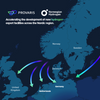American Association of Port Authorities' (AAPA) Chairman of the Board Dick Steinke, executive director of the Port of Long Beach, told Congress today that at least 52 U.S. public port agencies say they intend to apply for Department of Transportation Port Security Grants totaling $222.8 million. This far exceeds the $93.3 million appropriated by Congress for this program.
Steinke testified on behalf of AAPA during a hearing of the Subcommittee on Coast Guard and Marine Transportation, House Transportation and Infrastructure Committee. As state and local government agencies, Steinke said in written testimony, public port authorities warrant Federal help and assistance, to avoid new requirements becoming unfunded Federal mandates. Grants, he explained, are the best way to do this. "We encourage the House Transportation and Infrastructure Committee to authorize soon a continuation of the grant program to help secure America's ports."
According to AAPA, the grant applications proposed by individual ports will range from $100,000 to $50 million; 27 respondents indicate they intend to request $1 million or more.
The Transportation Security Agency (TSA) is implementing the Port Security Grants Program in coordination with the Maritime Administration (MARAD) and the U.S. Coast Guard (USCG). TSA is planning to award competitive grants starting in June 2002 to critical national seaports. The grants will finance the cost of enhancing facility and operational security.
AAPA surveyed its 85 U.S. Corporate member ports in February to assess the measures ports took immediately following September 11 to enhance security, and the costs associated with making these improvements. AAPA also asked ports to estimate the cost of funding future security enhancements. Sixty-seven percent of the Association's U.S. Corporate membership (58 public seaport agencies) responded to the survey questions.
The responses indicate that U.S. public seaports have spent at least $49 million for security-related enhancements prompted by the September 11 attacks. (Not all respondents provided dollar amounts and survey results exclude spending by non-responding ports, several of which are among the country's leading container, petroleum, and cruise passenger handlers.)
Spending by individual ports ranged from a low of $3,000 to a high of $10 million to date. Ports spent the most money on personnel-related costs (a recurring annual cost), including the hiring of new officers and overtime. Fencing, identification systems, lighting, and gate/entry controls accounted for most of the remaining expenses incurred nationally, according to the survey.
With respect to the future, the responses indicate that the public port industry plans to invest at least $278.5 million for security enhancements. Forty-one percent will be invested in personnel (a recurring annual cost), gate/entry controls, and surveillance systems. Other top categories of investment were lighting, X-ray equipment, fencing and radiation detection equipment. (These are conservative figures because not all respondents indicated dollar amounts.)
Forty-eight ports stated that they had completed or were completing port security plans, in most cases on their own, although a few stated their plans had been prepared by, or in collaboration with, the local U.S. Coast Guard Captain of the Port (COTP).
Sponsored Content
Chris-Marine’s solutions help to prolong engine lifetime

Subscribe for
Maritime Reporter E-News
Maritime Reporter E-News is the maritime industry's largest circulation and most authoritative ENews Service, delivered to your Email five times per week












